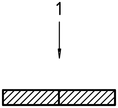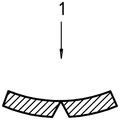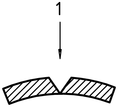ISO 6603-1-2000 “Kunststoffe – Bestimmung des Durchstoßverhaltens von Hartkunststoffen – Teil 1: Nicht-instrumentelle Aufprallprüfung”
Einführung
ISO (Internationale Standardisierungsorganisation) ist eine globale Allianz nationaler Normungsgremien (ISO-Mitgliedsorganisationen). Die Entwicklung internationaler Standards erfolgt in der Regel durch technische Komitees der ISO. Jede Mitgliedsinstitution, die an einem Thema interessiert ist, zu dem ein Fachausschuss eingerichtet wurde, hat das Recht, in diesem Ausschuss vertreten zu sein. An dieser Arbeit sind auch internationale Regierungs- und Nichtregierungsorganisationen beteiligt, die mit der ISO zusammenarbeiten. ISO arbeitet eng mit der International Electrotechnical Commission zusammen (IEC) in allen Fragen der elektrischen Normung.
Internationale Normen werden in Übereinstimmung mit den Regeln in Teil erstellt 3 der ISO/IEC-Richtlinie.
Der vom Technischen Komitee angenommene Entwurf einer internationalen Norm wird den Mitgliedsgremien zur Abstimmung vorgelegt. Die Veröffentlichung als internationaler Standard bedarf der Zustimmung von mindestens 75% der Mitgliedsinstitutionen.
Please note that some elements of this part of ISO 6603 Kann Gegenstand eines Patentrechts sein. ISO ist nicht dafür verantwortlich, einige oder alle dieser Patente zu identifizieren.
Der internationale Standard ISO 6603-1 was developed by the Technical Committee ISO/TC61, Kunststoffe, Unterausschuss SC 2, Mechanical Properties.
ISO 6603-1-2000 “Kunststoffe – Bestimmung des Durchstoßverhaltens von Hartkunststoffen – Teil 1: Nicht-instrumentelle Aufprallprüfung”
Die zweite Auflage ersetzt die technisch überarbeitete Erstauflage (ISO 6603-1:1985).
ISO 6603 besteht aus folgenden Teilen, under the general heading Plastics – Bestimmung des Durchstoßverhaltens von Hartkunststoffen:
– Teil 1: Nicht-instrumentelle Aufprallprüfung
– Teil 2: Instrumented impact testing
Appendix A of this part of ISO 6603 is for information purposes only.
1 Reichweite
This standard specifies a method for determining, under specified conditions, the puncture impact properties of rigid plastics in the form of flat specimens, such as disks or squares. The sample can be molded directly, cut from the sheet or removed from the finished product. Different types of samples and test conditions are defined.
ISO 6603-1-2000 “Kunststoffe – Bestimmung des Durchstoßverhaltens von Hartkunststoffen – Teil 1: Nicht-instrumentelle Aufprallprüfung”
These drop dart methods are used to study the behavior of plastic films or molds under the impact of a firing pin perpendicular to the specimen plane.
Dieser Teil von ISO 6603 can be used if it is sufficient to characterize the impact behavior of plastics by an impact failure energy threshold based on many samples. If a force-deflection or force-time plot recorded at a nominal constant firing pin speed is necessary to characterize impact behavior in detail, ISO 6603-2 wird eingesetzt.
These test methods are suitable for specimens with thicknesses between 1 mm und 4 mm.
Note For thicknesses less than 1 mm, ISO 7765 is recommended. If the equipment is suitable, it is possible to test thicknesses greater than 4 mm, but this test falls outside the scope of ISO 6603-1 und ISO 6603-2.
These methods are suitable for the following types of materials:
Rigid thermoplastic molding and extrusion materials, including filled, unfilled and reinforced compounds and sheets;
– Rigid thermosetting molding and extrusion materials, einschließlich Füll- und Verstärkungsmassen, sheets and laminates;
ISO 6603-1-2000 “Kunststoffe – Bestimmung des Durchstoßverhaltens von Hartkunststoffen – Teil 1: Nicht-instrumentelle Aufprallprüfung”
Fiber-reinforced thermoset and thermoplastic composites, including unidirectional or non-unidirectional reinforcement materials, such as MATS, woven fabrics, woven roving, cut strands, combined and mixed reinforcement materials, roving, milled fibers and sheets made from pre-impregnated materials (prepregs).
These methods are also applicable to samples molded or machined from finished products, laminates and extruded or cast plates.
The test results are comparable only when the preparation conditions, size and surface of the sample and the test conditions are the same. Insbesondere, the results determined on specimens of different thicknesses cannot be compared with each other (see Appendix E: – nach ISO 6603-2). A comprehensive assessment of the impact stress response requires measurement of the impact velocity and temperature of different material variables, such as crystallinity and moisture content.
The impact behavior of the finished product cannot be predicted directly from this test, but samples can be taken from the finished product (see above) for testing by these methods.
Test data developed through these methods should not be used in design calculations. Jedoch, information on the typical behaviour of the material can be obtained by testing at different temperatures and impact velocities (see Annex D of ISO 6603-2: -), varying thickness (see Annex E of ISO 6603-2: -) and testing samples prepared under different conditions.
Dieser Teil von ISO 6603 describes two statistical test methods:
– Methode A: Staircase Method (Individual) (preferred)
Bei dieser Methode, a uniform energy increment is used during the test. After testing each sample, the energy is reduced or increased by uniform increments, depending on the observations (pass or fail) of the previous test.
ISO 6603-1-2000 “Kunststoffe – Bestimmung des Durchstoßverhaltens von Hartkunststoffen – Teil 1: Nicht-instrumentelle Aufprallprüfung”
– Methode B: Group method (Optional)
Bei dieser Methode, a continuous group of at least ten samples is tested. The impact failure energy is calculated statistically.
2 Normative Verweisungen
The following normative documents contain provisions that, by reference herein, constitute the provisions of this part of ISO 6603. Für datierte Referenzen, any subsequent revisions or amendments to these publications will not apply. Jedoch, Parties to agreements based on this part of ISO 6603 werden ermutigt, die Möglichkeit der Anwendung neuer Versionen der folgenden normativen Dokumente zu prüfen. Für undatierte Referenzen, a new version of the standard-setting document referred to applies. ISO- und IEC-Mitglieder führen ein Register der aktuell gültigen internationalen Standards.
ISO 291:1997, Kunststoffe. Adjust and test the standard atmosphere.
ISO 293:1986, Kunststoffe. Compression forming sample of thermoplastic material.
ISO 294-3:1996, Kunststoffe. Spritzgießen von thermoplastischen Materialproben. Teil 3: Small board.
ISO 295:1991, Kunststoffe. Compression molding of thermosetting material samples.
ISO 1268:19741), Kunststoffe – Preparation of glass fiber reinforced, resin bonded, low pressure laminates or panels for test purposes.
ISO 2818:1994, Kunststoffe. The sample was prepared by machining.
ISO 7765-1:1988, Kunststofffolien und -platten. The impact resistance was determined by the free falling dart method. Teil 1: Staircase method.
ISO 7765-2:1994, Kunststofffolien und -platten. The impact resistance was determined by the free fall dart method. Teil 2: Instrumenteller Punktionstest.
ISO 6603-1-2000 “Kunststoffe – Bestimmung des Durchstoßverhaltens von Hartkunststoffen – Teil 1: Nicht-instrumentelle Aufprallprüfung”
3 Begriffe und Definitionen
Für die Zwecke dieses Teils der ISO 6603, Es gelten die folgenden Begriffe und Definitionen:
3.1 Überblick
3.1.1 Failure
Any visible breakage of the specimen surface
3.2 Failure standard terms
3.2.1 Crack
Any cracks that are visible to the naked eye and cannot penetrate the entire thickness of the material
Sehen: Figur 1
3.2.2 Broken
Any cracks throughout the entire thickness of the material
Sehen: Figur 2
3.2.3 Penetration
Failure of the firing pin to penetrate the entire thickness of the specimen
Sehen: Figur 3 B)
3.2.4 Grinding
Break the sample into two or more pieces
Sehen: Figur 3 A)
3.3 Impact failure items
3.3.150 % impact failure energy E50
The energy that causes 50% of the sample to fail, as defined in 3.1.1
3.3.250 % impact failure mass M50
The mass that causes 50% of the sample to fail at a given fall height, as defined in 3.1.1
3.3.350 % impact failure mass H50
50% impact failure height H50 uses the height at which a given falling mass causes 50% sample failure, as defined in 3.1.1
Figur 1 – Specimen sections damaged by “cracks” [B) and c) after bending by hand
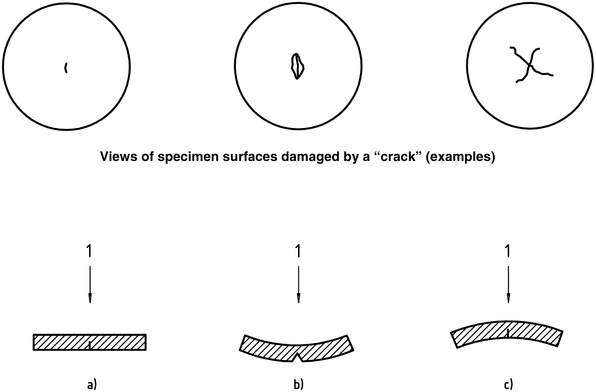
| 1 | Impact direction |
ISO 6603-1-2000 “Kunststoffe – Bestimmung des Durchstoßverhaltens von Hartkunststoffen – Teil 1: Nicht-instrumentelle Aufprallprüfung”
Figur 2 – Slices passed through the specimen are damaged by “breakage” [B) and c) after bending by hand
| A)
| B)
| C)
|
| 1 | Impact Direction |
Figur 3 – Examples of “broken” failures [A) Und “penetrated” [B)
A)
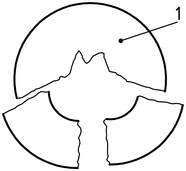
B)
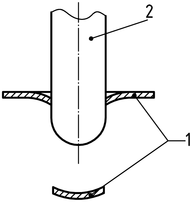
| 1 | Probe |
| 2 | Darts with hemispherical heads |
Nur der Standardinformationsbereich ist öffentlich. Um den vollständigen Inhalt zu sehen, Sie müssen den Standard über die offiziellen Kanäle erwerben.

